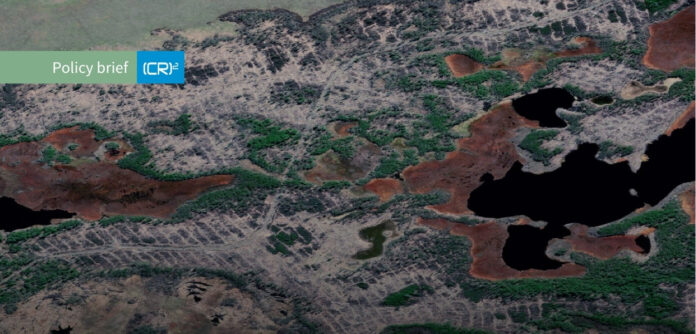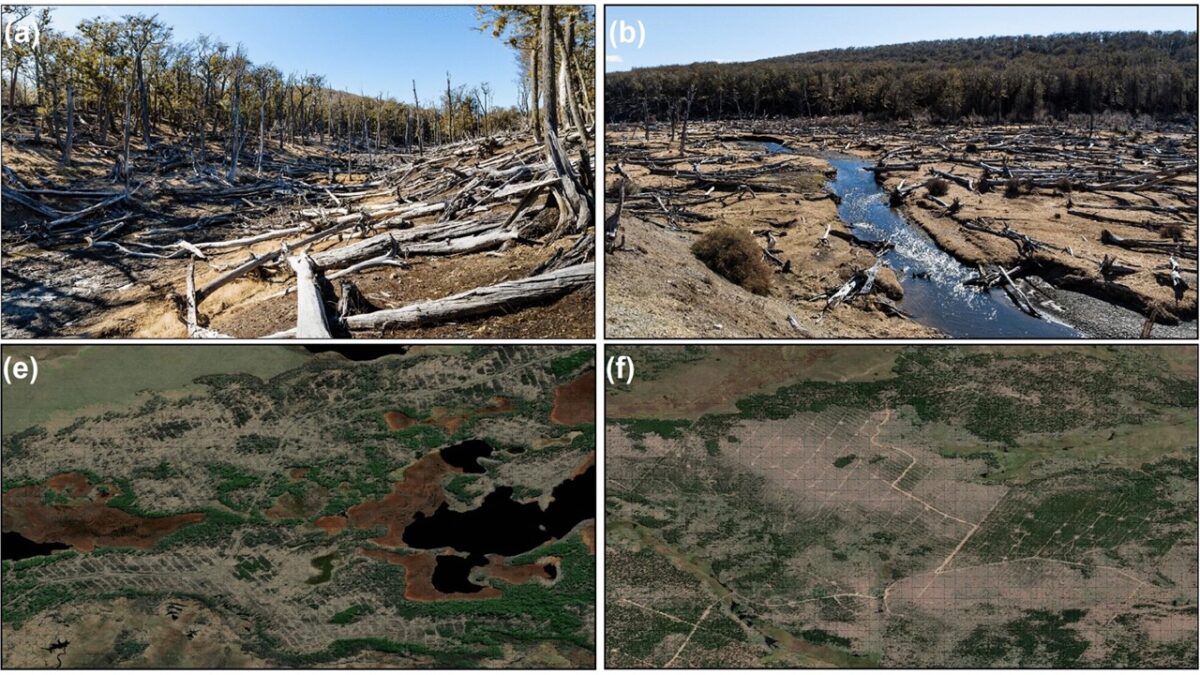By Alejandro Miranda, Department of Forest Sciences, University of La Frontera and CR2 Associate Researcher; Jorge Hoyos-Santillan, Associate Researcher Smithsonian Tropical Research Institute and CR2 Associate Researcher; Antonio Lara, CR2 Associate Researcher; Rayén Mentler, ETH Zurich; Alejandro Huertas-Herrera, Center for Research on Patagonian Ecosystems (CIEP) Researcher; Mónica Toro-Manríquez, CIEP Researcher; and Armando Sepúlveda-Jauregui, CR2 Collaborating Researcher and IGB-Leibniz Researcher.
- Forestry activity contributed around 46% to carbon loss, while beavers contributed around 54%.
- Native forest cover has decreased by 15.5% over thirty years. Of this percentage, 56% was due to the impact of beavers and 44% to forestry activity.
Native forests are not just important, they are crucial in mitigating climate change. Their unique ability to capture and store carbon is vital to our planet’s natural defense system. However, these ecosystems have always been under constant threat due to industrial timber extraction, agricultural expansion, grazing, and wildfires.
Globally, 35% of the native forest cover that existed since the pre-industrial era has been lost, and less than 20% has remained largely undisturbed. The most significant loss has occurred in Latin America, mainly due to agriculture and logging, in addition to other factors such as invasive species introduced by humans.
In the case of the forests of Southern Patagonia, the impacts have been smaller, making them a crucial part of Chile’s climate strategy. These forests hold the southernmost carbon reservoirs on the planet, but they are also considered unrecoverable if affected, as their recovery can take centuries. This underscores the urgent need for conservation efforts.
Despite the above, Southern Patagonia has been affected by various disturbances. One of them is beavers, a species introduced to the Isla Grande de Tierra del Fuego from Argentina in 1946, which increased from 50 to more than 100,000 individuals, colonising 98% of its basins, building more than 200,000 dams and impacting the cover and carbon reservoirs of the natural forests dominated mainly by lenga. Another significant disturbance has been the industrial logging of forests, which remains an economically important activity in the area.
To determine the loss of native forest cover and carbon reservoirs over the last 30 years (1986-2019), a study was conducted to compare the impact of both beavers and tree felling within the Chilean territory of Tierra del Fuego. The results were published in the journal Scientific Reports and are summarised below.
Figure 1. Satellite images from 2020 (Google Earth) show beavers’ impact along major waterways. The orange area in the second image is peatlands.
Loss of Cover and Carbon Reserves
The study shows that the native forest cover of Tierra del Fuego decreased by 15.5% between 1986 and 2019. Of this percentage, beavers were responsible for 56%, while forestry activity accounted for 44%. It is essential to indicate that the impact of beavers was more significant in lands near streams, lakes, and peatlands in remote southern areas. Meanwhile, the effect of tree felling was more critical in the north, in areas close to transportation routes.
Regarding carbon reserves, it is estimated that beavers contributed to a carbon loss of 1.4 million tons, while tree felling contributed 1.2 million tons. However, native forests impacted by tree felling lost 47% of their carbon storage, while those affected by beavers lost 44%. It should be noted that there were differences in this loss, as beavers redistribute reserves in living and dead biomass, while tree felling represents a direct extraction of carbon from the ecosystem.
Figure 2. In images A and B, the waterways affected by beavers and dead biomass can be seen. In images C and D, the impact of forestry activity is visible. Source: Miranda et al., 2023. Images A and B were taken by Jorge Hoyos-Santillán, and images C and D are from Google Earth. All from 2020.
These values differ from the idea that beavers are the only disturber of forest cover, as their impact is very similar to that caused by logging. Furthermore, the damage caused by beavers and forestry activity persists over time. For example, the dams associated with beavers affect the structure of the forests and biodiversity and change soil moisture, which limits natural regeneration. On the other hand, tree felling increases the forest’s susceptibility to being affected by wind, biological invasions, droughts, or browsing.
The indirect impact of forest loss could be even more significant, affecting the hydrological regime in peatlands, ecosystems of vital importance for mitigating climate change, as they contain approximately five times more carbon than all the forests and plantations in the country (Hoyos-Santillán et al. 2019). In Tierra del Fuego, it has been observed that beavers, in certain peatlands where they establish themselves, create channels that partially drain them, which decreases their groundwater, altering the dynamics of carbon within this ecosystem.
Recommendations
- Chile’s climate strategy for carbon neutrality depends on native forests. Therefore, to meet its Nationally Determined Contribution, emphasis will have to be placed on protecting these Patagonian ecosystems, which comprise more than 70% of the country’s native forest.
- Policies and programs focused on the conservation, restoration, and management of these forests should be developed, but considering the impact of both beavers and forestry activity in the national climate strategy to meet Chile’s climate change mitigation commitments.
- To establish the best strategies to meet this objective, the time horizons for the recovery of natural forests must be considered compared to the horizon considered for carbon neutrality.
- Old-growth forests, considered irretrievable carbon reservoirs on a global scale, must be preserved throughout the national territory as the number one strategy to achieve carbon neutrality. This is consistent with international commitments to bring to zero the loss of ecosystems of high ecological integrity due to their importance for biodiversity (UNEP, 2022).
- Avoiding the loss of high-carbon reservoir ecosystems, such as old-growth forests and peatlands, is the most cost-effective alternative to meet national and international commitments in the context of global changes.
References
Hoyos-Santillan, J., Miranda, A., Lara, A., Rojas, M., & Sepulveda-Jauregui, A. (2019). Protecting Patagonian peatlands in Chile. Science, 366(6470), 1207-1208.
Miranda, A., Hoyos-Santillan, J., Lara, A., Mentler, R., Huertas-Herrera, A., Toro-Manríquez, M. D., & Sepulveda-Jauregui, A. (2023). Equivalent impacts of logging and beaver activities on aboveground carbon stock loss in the southernmost forest on Earth. Scientific Reports, 13(1), 18350.
United Nations Environment Programme (UNEP). (2022). The COP15 concludes with a historic agreement for biodiversity. https://www.unep.org/news-and-stories/story/cop15-concludes-historic-agreement-biodiversity







